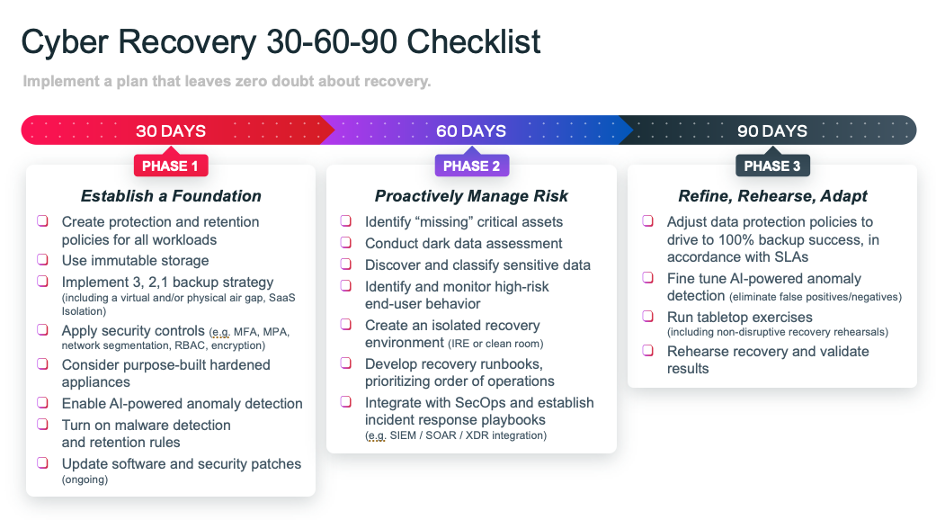How to Remove Doubt with a Cyber Recovery Checklist

The Flashpoint 2024 Global Threat Intelligence Report highlights a crisis. We cannot ignore this crisis. In 2023 alone, hackers compromised a staggering 17 billion personal records. Marking a fourfold increase from the previous year. This alarming spike represents millions of people. Identity theft, financial fraud, and other exploitation are turning lives upside down. The ramifications of such extensive data breaches are profound. These breaches are hurting people now.
There is a clear arms race between cybercriminals and cybersecurity pros. Ransomware attacks have become more common and sophisticated. The U.S. Department of Homeland Security has seen a 300% increase in ransomware attacks in recent years. The average cost of a ransomware breach is now over $4 million. Ransomware breaches disrupt operations and harm reputations, and they can also affect national security.
This spike also highlights a growing weakness in our mechanisms to protect our personal data. And this isn’t specific to a single industry or region either. Every industry and region is experiencing a rise in successful data breaches. Much of this is due to legacy protection measures and needing more data protection fundamentals. A defensive and reactive approach is no longer enough. The theft of 17 billion records shows a critical need. A need that aims for better data protection and cyber recovery plans to keep personal information and organizations’ sensitive data safe.
The Evolving Threat Landscape
Cyber threats have become more complex and stealthier. This is a big shift. Gone are the days when cyber attackers leveraged simple malware or phishing campaigns. They have evolved. Today, they use advanced techniques, often supported by sophisticated networks with significant financial resources. This grants them access to innovative tactics like deepfake technology and AI-powered social engineering attacks, to name a few.
These new tactics allow attackers to bypass traditional security methods and often result in acquiring credentials. Essentially allowing them to login, often unnoticed. According to IBM’s Data Breach Action Guide, it takes 277 days on average to identify and contain a breach: 207 days to identify and 70 days to contain. This means the cyber criminals have the time, resources, and opportunity to select the greatest target to hold your data hostage.
Strong cybersecurity fundamentals and proven industry best practices are crucial to helping mitigate these new threats. With all the growing threats, methods are evolving fast. Organizations must act now and be prepared for today's cyber-attacks. How, might you ask? That is where a helpful checklist comes in.
Business Resilience with a Cyber Recovery Checklist

Building a Firm Foundation
Every good cyber recovery strategy needs a solid base. This starts with creating protection plans, applying the right security controls, and retention policies that align to your business requirements. Make sure your backups are also immutable. Immutable storage will keep your backup data intact when you need it the most. You should also keep three copies of your backups on two different media with only copy offsite or isolated. Remember to further reduce your attack surface with purpose-built hardened appliances.
To learn more about simple steps to establish a foundation for cyber recovery watch this short lightboard video.
Managing Your Risk
In phase 2, the focus shifts to your teams, including the people, processes and technology that supports your backup infrastructure. Proactive risk management includes conducting regular dark data and risk assessments. Discovering and classifying sensitive data. And critically, the setup of an isolated recovery environment—a clean room where you can recover and validate that all malware has been eradicated. Make sure all of these plans are documented in recovery runbooks and prioritize according to your most critical business applications.
To learn more about proactive risk management watch this short lightboard video.
Refining, Rehearsing, and Adjusting Your Plan
The most comprehensive part of your cybersecurity strategy is its focus on teams and helping them refine to improve. Securing your data is not a one-time task. It is an ongoing process. It needs regular evaluation, testing, and refinement. The checklist prompts organizations to review and update their cybersecurity. Organizations can test their incident response and recovery plans in a controlled environment. You do this through regular recovery drills and simulations. For example, you should use tabletop exercises and red teaming. The rehearsals provide invaluable insights into how well current strategies work. It also helps build muscle memory in teams and ensures a fast and coordinated response to real incidents.
To learn more about refining, and rehearsing your recovery plan watch this short lightboard video.
Final Thoughts
A cyber recovery checklist has power. It can transform the vague and overwhelming task of cyber recovery into clear, proactive planning. So that while you and your teams are under pressure, there are clear actions and processes to implement. It turns it into a structured, manageable, and dynamic process. It offers a roadmap for organizations. Your enterprise can defend against today's threats and foresee and lessen tomorrow's risks. You can do this by setting a solid foundation and managing risks. And by tweaking your approach. You can use your cyber recovery checklist as a powerful tool. One that you can use to navigate the digital age with confidence, zero doubt, and resilience.
Learn more about how to apply Veritas 360 Defense to keep your applications resilient and your data protected, compliant, and recoverable, when it matters most.
